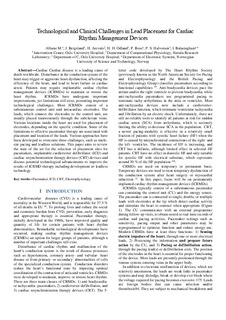Technological and clinical challenges in lead placement for cardiac rhythm management devices
Albatat, Mohammad; Bergsland, Jacob; Arevalo, Hermenegild; Odland, Hans Henrik; Bose, Pritam; Halvorsen, Per Steinar; Balasingham, Ilangko
Abstract
CardiacCardiacdisease is aleading cause of death worldwide. Disturbance in the conduction system of the heart may trigger or aggravate heart dysfunction, affecting the efficiency of the heart, and lead to heart failure or cardiac arrest. Patients mayrequire implantable cardiac rhythm management devices (ICRMDs) to maintain or restore the heart rhythm. ICRMDs have undergone important improvements, yet limitations still exist, presentingimportant technological challenges. Most ICRMDs consist of a subcutaneous control unit and intracardiac electrodes. The leads, which connect the electrodes to the control unit, are usually placed transvenously through the subclavian veins. Various locations inside the heart areusedfor placement of electrodes, depending on the specific condition. Some of the limitationsto effective pacemaker therapyare associated with placement and location of the leads. Various approaches have been developed to overcome these challenges, such as multi-site pacing and leadless solutions.This paper aims to review the state of the art for the selection of placement sites for pacemakers, implantable cardioverter defibrillator (ICD)and cardiac resynchronization therapy devices (CRT)devices and discuss potential technological advancements to improve the results of ICRMD-therapyincluding development av leadless technology
